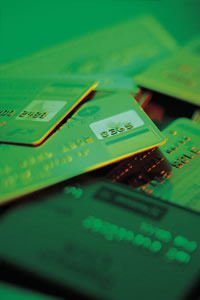Money Basics
Credit
Introduction
By the end of this lesson, you should be able to:
- Discuss the proper and improper use of credit
- Obtain a credit report
- Take steps to update or correct errors in a credit report
What is credit?
Credit is a contractual agreement that allows you to receive a loan and pay it back later. There are three types of credit accounts:

- Revolving agreement
Banks, gas and oil companies, and department stores typically issue credit cards based on a revolving credit agreement. You can either pay the full amount due each month or make a minimum payment—an amount less than what you owe. - Charge agreement
Charge cards—not credit cards—and charge accounts with some businesses often require repayment based on a revolving agreement. You promise to pay the balance in full each month to avoid paying interest charges. - Installment agreement
Automobiles, furniture, and major appliances are often financed via an installment agreement. You agree to pay back a fixed amount in equal payments over a certain period of time. Personal loans are also sometimes paid back in installments.
Payments and finance charges
Many people get credit cards to pay for goods and services. If you pay the full amount you owe when your credit card bill arrives, you can avoid paying extra fees. However, if you only make the minimum payment, the interest or finance charges (the amount you pay for using credit) can build up significantly. The more money you owe on your credit card, the higher the finance charges will be.
Let's imagine that you bought a fancy TV set that costs $1,000 on a credit card with a 15 percent interest rate. Depending on how long you take to pay off your credit card balance, you could spend hundreds of dollars in interest.
| Monthly Payment | Time to Pay Off | Interest Paid | Total Cost of Loan |
|---|---|---|---|
| $ 100.00 | 11 months | $ 74.91 | $ 1074.91 |
| $ 50.00 | 1 year, 11 months | $ 157.91 | $ 1157.91 |
| $ 30.00 | 3 years, 7 months | $ 301.66 | $ 1301.66 |
| $ 20.00 | 6 years, 7 months | $ 579.11 | $ 1579.11 |
To avoid getting deep into credit card debt, do one or more of the following:
- Pay off the cards with the highest finance charges first.
- Pay more than the minimum payment required each month, if possible.
- Use cash to make purchases, if possible. Use a credit card only in emergencies or when necessary, such as for car rental.
- If you use a credit card, pay the full amount each month instead of letting finance charges accrue.
- Replace higher-rate credit cards with lower-rate ones. Be sure to read and evaluate credit card offers carefully to make sure you are getting the best deal. Often, low introductory offers allow you time to pay off your credit card balances. However, make sure that a 0 percent interest rate doesn't climb to 19 percent or higher in a few months.
The interest rate can make a significant difference in how much you pay for an item. If you purchased a $1,000 item and paid $30 each month at various interest rates, here's what could happen.
| Monthly Payment | Interest Rate | Time to Pay Off | Interest Paid | Total Cost of Loan |
|---|---|---|---|---|
| $ 30.00 | 20% | 4 years, 1 month | $ 471.80 | $ 1471.80 |
| $ 30.00 | 15% | 3 years, 7 months | $ 301.66 | $ 1301.66 |
| $ 30.00 | 10% | 3 years, 3 months | $ 176.40 | $ 1176.40 |
| $ 30.00 | 5% | 3 years | $ 78.87 | $ 1078.87 |
If you want to determine the finance charges on a product or service you might purchase with a credit card, enter the cost, interest rate, and payment. For example, how much does that $700 stereo system really cost at an interest rate of 15 percent?
It can be amazing what a difference an interest or payment amount can make in how much you end up spending.
Choosing a credit card

If you are considering getting a credit card, shop around for the one that best fits your needs and that won't leave you struggling financially. Check with your local bank, evaluate offers you might get in the mail, visit the websites of major credit card companies, and check out other online resources.
Look for a card that has:
- A low interest rate
- No annual fees
- A grace period
What do these terms mean?
Interest rates on credit cards change over time. Variable-rate cards are linked to changes in other interest rates such as the prime rate. Fixed-rate cards are not directly linked to changes in other interest rates.
An annual fee is an annual charge similar to a membership fee.
A grace period is a time—usually 25 days—during which you can pay your credit card bill without paying a finance charge. A grace period usually only applies if you pay your balance in full each month. It does not apply to cash advances or if you carry a balance forward.
You might also consider cards that offer extras for using them. Some cards offer cash back for purchases, frequent-flier miles, or Internet access. However, be careful. These cards may require you to make large purchases before you can take advantage of these incentives. Never base your credit card decision solely on possible incentives.
Make sure you totally understand a plan's terms before you accept the credit card.
Other types of cards
If you have trouble controlling your spending, consider:
- A secured card
Some banks offer secured cards. You deposit a certain amount in a bank to serve as collateral. You can then get a Visa or MasterCard with a credit limit equal to the amount in the bank. The money must remain in the account while you have the card. The downside is that secured cards usually come with a higher interest rate and annual fees. One advantage to a secured card is that if you show that you are responsible with a secured card, issuers may be more likely to consider you for a traditional credit card. - A debit card
Most banks offer debit cards in addition to traditional checking accounts. This card also features the Visa or MasterCard logo, but the money is drawn directly from your bank account. Because the money comes out of the account shortly after you use the card, keep track of your spending just as if you were writing checks. Some banks charge annual or monthly fees for debit cards.
You'll learn more about debit cards later in this tutorial.
Tips for protecting your credit cards
Protect your credit cards and account numbers to prevent unauthorized use by taking these steps:
- Don't give your card number over the phone unless you have initiated the call. Make sure you're giving it to a reputable company or organization.
- Never lend your credit card to anyone.
- Never give your credit card number to someone for a purpose you do not understand.
- Keep a record—in a safe place separate from your cards—of your account numbers, expiration dates, and the phone numbers of each issuer. This will enable you to report a loss quickly.
- Limit the number of credit cards you have, and cancel any inactive accounts. Carry only the cards you think you'll use.
- If carbon paper is used, make sure you get the carbon or that it gets destroyed.
- When you sign a sales slip, draw a line through any blank spaces above the Total line to keep other charges from being added.
- Keep your receipts to check charges when your bill arrives. You have a right to question any unfamiliar charges.
- Never leave your credit card in a purse or wallet that is unattended or in open view in a vehicle, even if the vehicle is locked.
- Before throwing them away, shred any documents and receipts that show your credit card number.
- Shred any offers of pre-approved credit cards before throwing them away.
- If you don't receive your credit card statement on time, notify the company immediately.
Credit reports and ratings
A credit report is an overview of your financial life. It lists—in great detail—information about how much you owe, any loans you have defaulted on, and late payments. It may also reveal whether you've been arrested or sued or have filed for bankruptcy. It is the content of your credit report that makes up your credit rating.
Also known as a credit score, a credit rating is a three-digit number between 300 and 800 that represents your credit risk to lenders. Your credit rating affects your ability to borrow money, your ability to obtain health insurance and in some cases your ability to get a job. A bad credit rating can also increase the cost of using credit.
To help you obtain a solid credit rating:
- Make all payments on time. Late payments can damage your credit rating.
- Open and responsibly maintain a checking or savings account. This shows that you have money to pay bills and that you're setting money aside for the future.
- Get a credit card, and use it only when you can comfortably repay it. To establish good credit, you need to use credit regularly. However, don't overuse it. Lenders may become concerned that you won't be able to pay your bills.
- Don't apply for too many credit cards. Applying for several cards can hurt your credit rating.
To determine whether you have a good or poor credit rating, obtain a credit report. Although some companies offer to sell you a copy of your credit report for as much as $50, basic credit reports are available for as low as $9.
You can order a credit report from one of the three major credit reporting agencies:
- Equifax, www.equifax.com, (800) 685-1111
- Experian, www.experian.com, (888) 397-3742
- TransUnion, www.transunion.com, (800) 888-4213
Under the Fair Credit Reporting Act, anyone denied credit must be provided a free copy of their credit report if they request one. The credit bureau that provided the initial report to the company that denied credit must provide the report.
Reviewing a credit report

Periodically review your credit report for errors or omissions, especially if you are considering a major purchase such as a car or home. You should also review your credit report for signs of possible credit fraud or identity theft. By closely monitoring your credit report, you may be able to stop any criminal activity in its early stages.
Correcting your credit report
Under the Fair Credit Reporting Act, businesses can use the information in your report to evaluate your applications for credit. You have the right to dispute any inaccurate information. Follow these steps when disputing items in your credit report.
- Clearly explain what information should be corrected.
Contact the credit-reporting agency and tell the person you speak to what information you believe is inaccurate or should be updated. Keep copies of any correspondence you send or notes on any phone conversations. Check out the Federal Trade Commission's sample dispute letter. - Know what to expect.
Within 30 days, the credit-reporting agency will investigate the disputed information. If it is found to be inaccurate, the creditor involved must notify all nationwide credit-reporting agencies so your file can be corrected. - Get the results in writing.
If your dispute results in a change to your credit report, the credit bureau will give you the written results and a free copy of your report. - If you can't get information removed, consider explaining.
You have the legal right to attach a letter of explanation to your credit file. Send this explanation to the three major credit bureaus, as well as to any business that was involved. The business is obligated to include your letter in any future input to the credit bureaus. - Businesses that guarantee to remove negative information from your credit file cannot provide such a remedy. According to the Federal Trade Commission, these "credit-repair companies" charge anywhere from $50 to more than $1,000 and do little to nothing to improve your credit report.
Online
- AskMrCreditCard.com: Information on credit from Ask Mr. Credit Card
- Bankrate.com: Information to help you compare various credit cards
- CardWeb.com: Information on various credit card options
Offline
- Credit Repair Made Simple - Brian Eichhorn
- The Insider's Guide to Managing Your Credit: How to Establish, Maintain, Repair and Protect Your Credit - Deborah McNaughton


